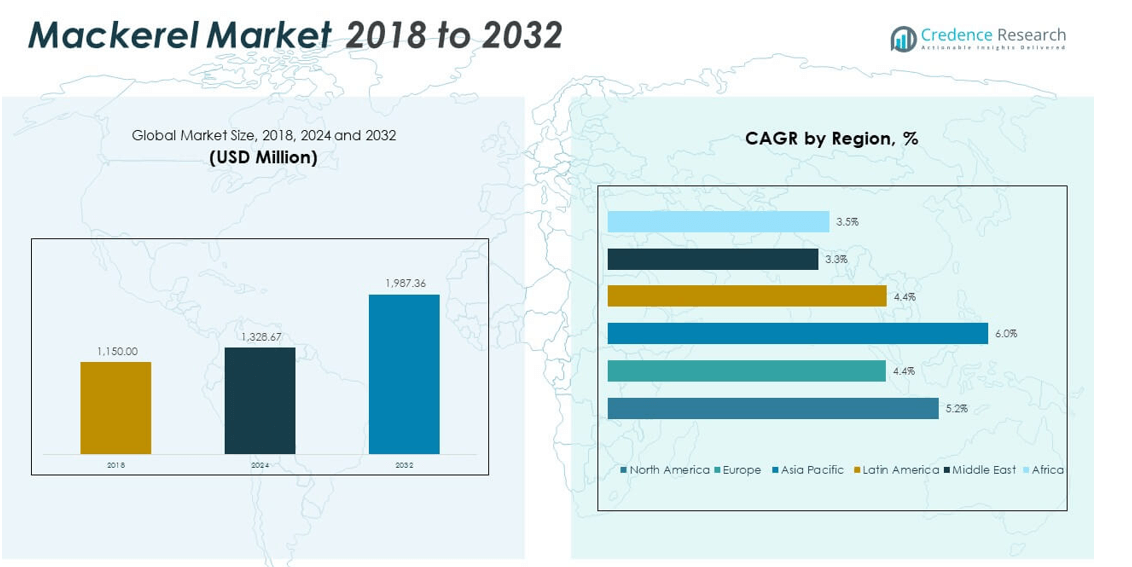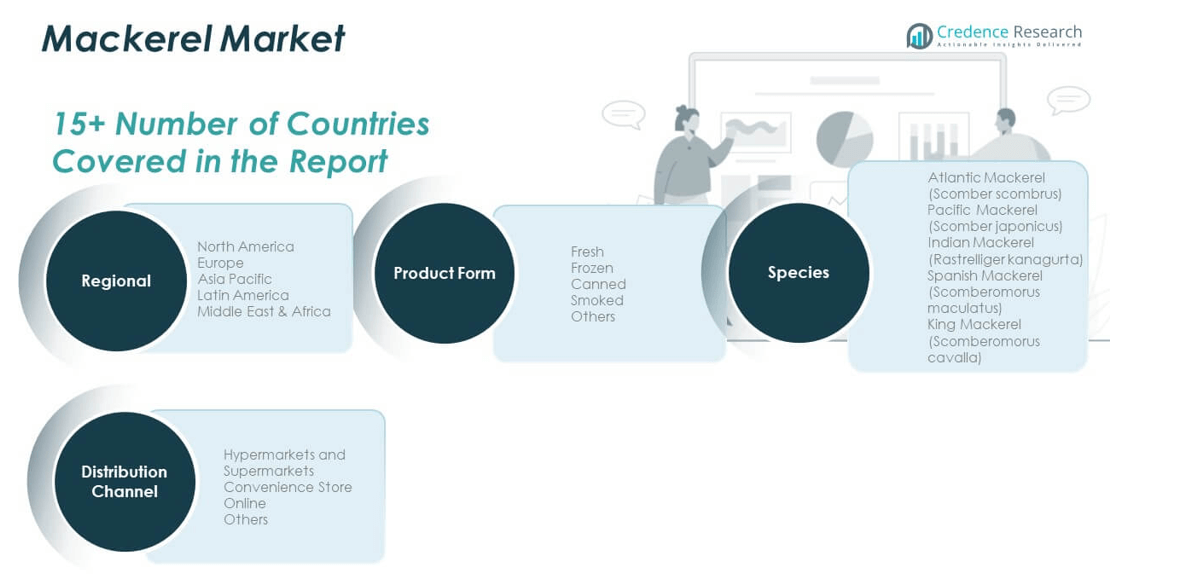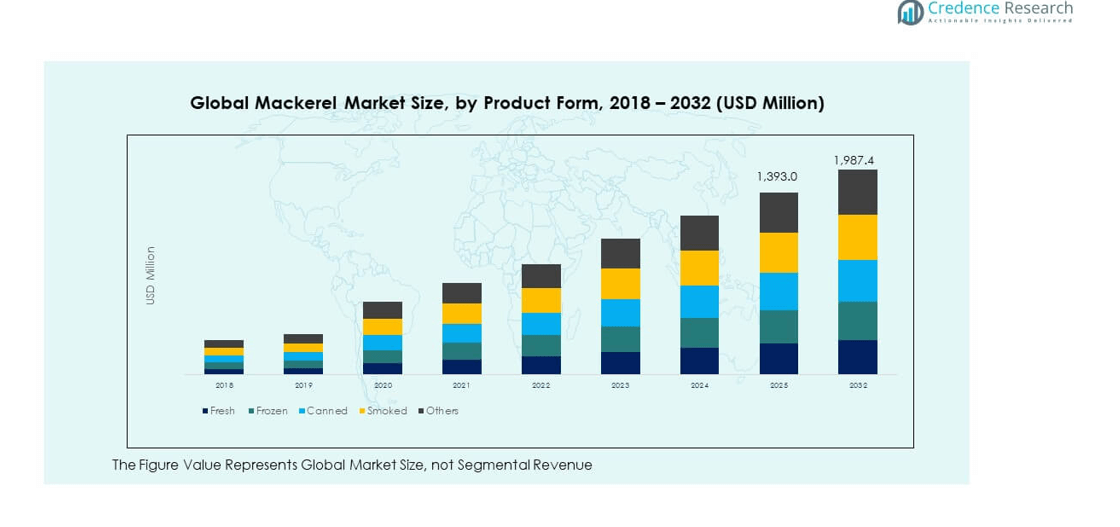CHAPTER NO. 1 : INTRODUCTION 26
1.1. Report Description 26
Purpose of the Report 26
USP & Key Offerings 26
1.2. Key Benefits for Stakeholders 27
1.3. Target Audience 27
CHAPTER NO. 2 : EXECUTIVE SUMMARY 28
CHAPTER NO. 3 : MACKEREL MARKET FORCES & INDUSTRY PULSE 30
3.1. Foundations of Change – Market Overview 30
3.2. Catalysts of Expansion – Key Market Drivers 32
3.3. Momentum Boosters – Growth Triggers 33
3.4. Innovation Fuel – Disruptive Technologies 33
3.5. Headwinds & Crosswinds – Market Restraints 34
3.6. Regulatory Tides – Compliance Challenges 35
3.7. Economic Frictions – Inflationary Pressures 35
3.8. Untapped Horizons – Growth Potential & Opportunities and Strategic Navigation – Industry Frameworks 36
3.9. Market Equilibrium – Porter’s Five Forces 37
3.10. Ecosystem Dynamics – Value Chain Analysis 39
3.11. Macro Forces – PESTEL Breakdown 41
3.12. Price Trend Analysis 43
3.12.1. Regional Price Trend 44
3.12.2. Price Trend by Product Type 44
3.13. Buying Criteria 45
CHAPTER NO. 4 : COMPETITION ANALYSIS 46
4.1. Company Market Share Analysis 46
4.1.1. Global Mackerel Market Company Revenue Market Share 46
4.2. Strategic Developments 48
4.2.1. Acquisitions & Mergers 48
4.2.2. New Product Type Launch 49
4.2.3. Agreements & Collaborations 50
4.3. Competitive Dashboard 51
4.4. Company Assessment Metrics, 2024 52
CHAPTER NO. 5 : GLOBAL MARKET ANALYSIS, INSIGHTS & FORECAST, BY PRODUCT FORM 53
CHAPTER NO. 6 : GLOBAL MARKET ANALYSIS, INSIGHTS & FORECAST, BY SPECIES 57
CHAPTER NO. 7 : GLOBAL MARKET ANALYSIS, INSIGHTS & FORECAST, BY DISTRIBUTION CHANNEL 61
CHAPTER NO. 8 : GLOBAL MARKET ANALYSIS, INSIGHTS & FORECAST, BY REGION 65
CHAPTER NO. 9 : NORTH AMERICA MARKET ANALYSIS, INSIGHTS & FORECAST, BY COUNTRY 70
9.1. North America Market Analysis, Insights & Forecast, by Product Form 72
9.2. North America Market Analysis, Insights & Forecast, by Species 73
9.3. North America Market Analysis, Insights & Forecast, by Distribution Channel 74
CHAPTER NO. 10 : EUROPE MARKET ANALYSIS, INSIGHTS & FORECAST, BY COUNTRY 75
10.1. Europe Market Analysis, Insights & Forecast, by Product Form 78
10.2. Europe Market Analysis, Insights & Forecast, by Species 79
10.3. Europe Market Analysis, Insights & Forecast, by Distribution Channel 80
CHAPTER NO. 11 : ASIA PACIFIC MARKET ANALYSIS, INSIGHTS & FORECAST, BY COUNTRY 81
11.1. Asia Pacific Market Analysis, Insights & Forecast, by Product Form 84
11.2. Asia Pacific Market Analysis, Insights & Forecast, by Species 85
11.3. Asia Pacific Market Analysis, Insights & Forecast, by Distribution Channel 86
CHAPTER NO. 12 : LATIN AMERICA MARKET ANALYSIS, INSIGHTS & FORECAST, BY COUNTRY 87
12.1. Latin America Market Analysis, Insights & Forecast, by Product Form 90
12.2. Latin America Market Analysis, Insights & Forecast, by Species 91
12.3. Latin America Market Analysis, Insights & Forecast, by Distribution Channel 92
CHAPTER NO. 13 : MIDDLE EAST MARKET ANALYSIS, INSIGHTS & FORECAST, BY COUNTRY 93
13.1. Middle East Market Analysis, Insights & Forecast, by Product Form 96
13.2. Middle East Market Analysis, Insights & Forecast, by Species 97
13.3. Middle East Market Analysis, Insights & Forecast, by Distribution Channel 98
CHAPTER NO. 14 : AFRICA MARKET ANALYSIS, INSIGHTS & FORECAST, BY COUNTRY 99
14.1. Africa Market Analysis, Insights & Forecast, by Product Form 102
14.2. Africa Market Analysis, Insights & Forecast, by Species 103
14.3. Africa Market Analysis, Insights & Forecast, by Distribution Channel 104
CHAPTER NO. 15 : COMPANY PROFILE 105
15.1. Thai Union Group Public Company Limited 105
15.2. John West Foods (part of Thai Union) 108
15.3. Pacific Andes International Holdings Limited 108
15.4. Maruha Nichiro Corporation 108
15.5. Nippon Suisan Kaisha, Ltd. 108
15.6. Company 6 108
15.7. Company 7 108
15.8. Company 8 108
15.9. Company 9 108
15.10. Company 10 108
15.11. Company 11 108
15.12. Company 12 108
15.13. Company 13 108
15.14. Company 14 108
List of Figures
FIG NO. 1. Mackerel Market Revenue Share, By Product Form, 2024 & 2032 53
FIG NO. 2. Market Attractiveness Analysis, By Product Form 54
FIG NO. 3. Incremental Revenue Growth Opportunity by Product Form, 2024 – 2032 55
FIG NO. 4. Mackerel Market Revenue Share, By Application, 2024 & 2032 57
FIG NO. 5. Incremental Revenue Growth Opportunity by Application, 2024 – 2032 58
FIG NO. 6. Incremental Revenue Growth Opportunity by Application, 2024 – 2032 59
FIG NO. 7. Mackerel Market Revenue Share, By Distribution Channel, 2024 & 2032 61
FIG NO. 8. Market Attractiveness Analysis, By Distribution Channel 62
FIG NO. 9. Incremental Revenue Growth Opportunity by Distribution Channel, 2024 – 2032 63
FIG NO. 10. Mackerel Market Revenue Share, By Region, 2024 & 2032 65
FIG NO. 11. Market Attractiveness Analysis, By Region 66
FIG NO. 12. Incremental Revenue Growth Opportunity by Region, 2024 – 2032 67
FIG NO. 13. Mackerel Market Revenue Share, By Country, 2024 & 2032 70
FIG NO. 14. Mackerel Market Revenue Share, By Country, 2024 & 2032 75
FIG NO. 15. Mackerel Market Revenue Share, By Country, 2024 & 2032 81
FIG NO. 16. Mackerel Market Revenue Share, By Country, 2024 & 2032 87
FIG NO. 17. Mackerel Market Revenue Share, By Country, 2024 & 2032 93
FIG NO. 18. Mackerel Market Revenue Share, By Country, 2024 & 2032 99
List of Tables
TABLE NO. 1. : Global Mackerel Market Revenue, By Product Form, 2018 – 2024 (USD Million) 56
TABLE NO. 2. : Global Mackerel Market Revenue, By Product Form, 2025 – 2032 (USD Million) 56
TABLE NO. 3. : Global Mackerel Market Revenue, By Species, 2018 – 2024 (USD Million) 60
TABLE NO. 4. : Global Mackerel Market Revenue, By Species, 2025 – 2032 (USD Million) 60
TABLE NO. 5. : Global Mackerel Market Revenue, By Distribution Channel, 2018 – 2024 (USD Million) 64
TABLE NO. 6. : Global Mackerel Market Revenue, By Distribution Channel, 2025 – 2032 (USD Million) 64
TABLE NO. 7. : Global Mackerel Market Revenue, By Region, 2018 – 2024 (USD Million) 68
TABLE NO. 8. : Global Mackerel Market Revenue, By Region, 2025– 2032 (USD Million) 69
TABLE NO. 9. : North America Mackerel Market Revenue, By Country, 2018 – 2024 (USD Million) 71
TABLE NO. 10. : North America Mackerel Market Revenue, By Country, 2025– 2032 (USD Million) 71
TABLE NO. 11. : North America Mackerel Market Revenue, By Product Form, 2018 – 2024 (USD Million) 72
TABLE NO. 12. : North America Mackerel Market Revenue, By Product Form, 2025 – 2032 (USD Million) 72
TABLE NO. 13. : North America Mackerel Market Revenue, By Species, 2018 – 2024 (USD Million) 73
TABLE NO. 14. : North America Mackerel Market Revenue, By Species, 2025 – 2032 (USD Million) 73
TABLE NO. 15. : North America Mackerel Market Revenue, By Distribution Channel, 2018 – 2024 (USD Million) 74
TABLE NO. 16. : North America Mackerel Market Revenue, By Distribution Channel, 2025 – 2032 (USD Million) 74
TABLE NO. 17. : Europe Mackerel Market Revenue, By Country, 2018 – 2024 (USD Million) 76
TABLE NO. 18. : Europe Mackerel Market Revenue, By Country, 2025– 2032 (USD Million) 77
TABLE NO. 19. : Europe Mackerel Market Revenue, By Product Form, 2018 – 2024 (USD Million) 78
TABLE NO. 20. : Europe Mackerel Market Revenue, By Product Form, 2025 – 2032 (USD Million) 78
TABLE NO. 21. : Europe Mackerel Market Revenue, By Species, 2018 – 2024 (USD Million) 79
TABLE NO. 22. : Europe Mackerel Market Revenue, By Species, 2025 – 2032 (USD Million) 79
TABLE NO. 23. : Europe Mackerel Market Revenue, By Distribution Channel, 2018 – 2024 (USD Million) 80
TABLE NO. 24. : Europe Mackerel Market Revenue, By Distribution Channel, 2025 – 2032 (USD Million) 80
TABLE NO. 25. : Asia Pacific Mackerel Market Revenue, By Country, 2018 – 2024 (USD Million) 82
TABLE NO. 26. : Asia Pacific Mackerel Market Revenue, By Country, 2025– 2032 (USD Million) 83
TABLE NO. 27. : Asia Pacific Mackerel Market Revenue, By Product Form, 2018 – 2024 (USD Million) 84
TABLE NO. 28. : Asia Pacific Mackerel Market Revenue, By Product Form, 2025 – 2032 (USD Million) 84
TABLE NO. 29. : Asia Pacific Mackerel Market Revenue, By Species, 2018 – 2024 (USD Million) 85
TABLE NO. 30. : Asia Pacific Mackerel Market Revenue, By Species, 2025 – 2032 (USD Million) 85
TABLE NO. 31. : Asia Pacific Mackerel Market Revenue, By Distribution Channel, 2018 – 2024 (USD Million) 86
TABLE NO. 32. : Asia Pacific Mackerel Market Revenue, By Distribution Channel, 2025 – 2032 (USD Million) 86
TABLE NO. 33. : Latin America Mackerel Market Revenue, By Country, 2018 – 2024 (USD Million) 88
TABLE NO. 34. : Latin America Mackerel Market Revenue, By Country, 2025– 2032 (USD Million) 89
TABLE NO. 35. : Latin America Mackerel Market Revenue, By Product Form, 2018 – 2024 (USD Million) 90
TABLE NO. 36. : Latin America Mackerel Market Revenue, By Product Form, 2025 – 2032 (USD Million) 90
TABLE NO. 37. : Latin America Mackerel Market Revenue, By Species, 2018 – 2024 (USD Million) 91
TABLE NO. 38. : Latin America Mackerel Market Revenue, By Species, 2025 – 2032 (USD Million) 91
TABLE NO. 39. : Latin America Mackerel Market Revenue, By Distribution Channel, 2018 – 2024 (USD Million) 92
TABLE NO. 40. : Latin America Mackerel Market Revenue, By Distribution Channel, 2025 – 2032 (USD Million) 92
TABLE NO. 41. : Middle East Mackerel Market Revenue, By Country, 2018 – 2024 (USD Million) 94
TABLE NO. 42. : Middle East Mackerel Market Revenue, By Country, 2025– 2032 (USD Million) 95
TABLE NO. 43. : Middle East Mackerel Market Revenue, By Product Form, 2018 – 2024 (USD Million) 96
TABLE NO. 44. : Middle East Mackerel Market Revenue, By Product Form, 2025 – 2032 (USD Million) 96
TABLE NO. 45. : Middle East Mackerel Market Revenue, By Species, 2018 – 2024 (USD Million) 97
TABLE NO. 46. : Middle East Mackerel Market Revenue, By Species, 2025 – 2032 (USD Million) 97
TABLE NO. 47. : Middle East Mackerel Market Revenue, By Distribution Channel, 2018 – 2024 (USD Million) 98
TABLE NO. 48. : Middle East Mackerel Market Revenue, By Distribution Channel, 2025 – 2032 (USD Million) 98
TABLE NO. 49. : Africa Mackerel Market Revenue, By Country, 2018 – 2024 (USD Million) 100
TABLE NO. 50. : Africa Mackerel Market Revenue, By Country, 2025– 2032 (USD Million) 101
TABLE NO. 51. : Africa Mackerel Market Revenue, By Product Form, 2018 – 2024 (USD Million) 102
TABLE NO. 52. : Africa Mackerel Market Revenue, By Product Form, 2025 – 2032 (USD Million) 102
TABLE NO. 53. : Africa Mackerel Market Revenue, By Species, 2018 – 2024 (USD Million) 103
TABLE NO. 54. : Africa Mackerel Market Revenue, By Species, 2025 – 2032 (USD Million) 103
TABLE NO. 55. : Africa Mackerel Market Revenue, By Distribution Channel, 2018 – 2024 (USD Million) 104
TABLE NO. 56. : Africa Mackerel Market Revenue, By Distribution Channel, 2025 – 2032 (USD Million) 104










